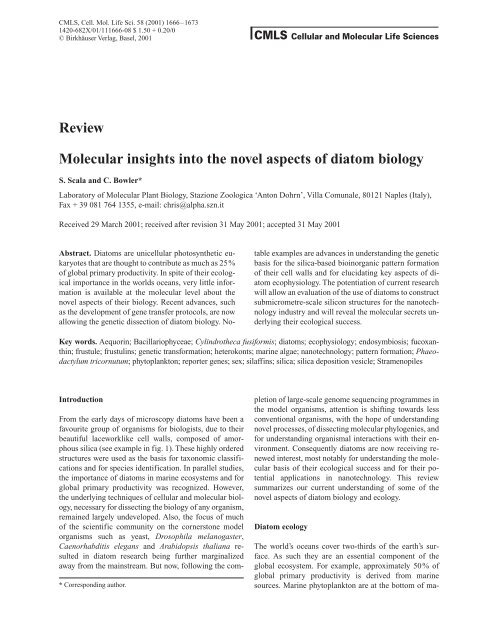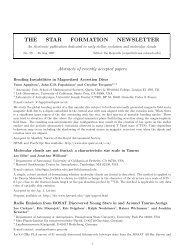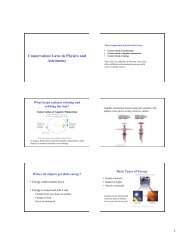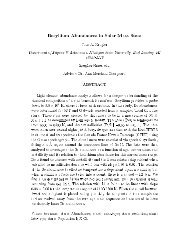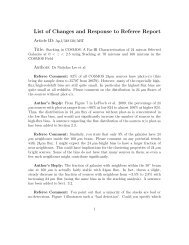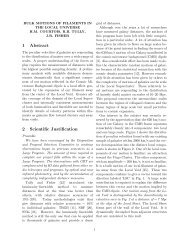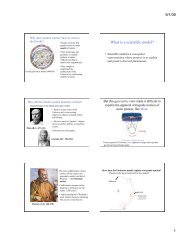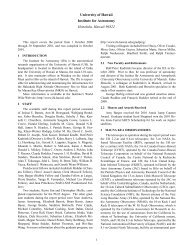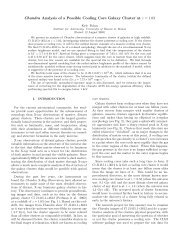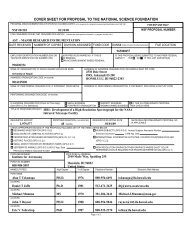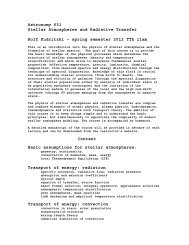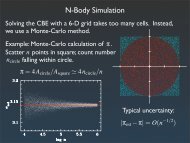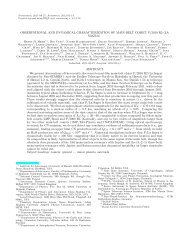Review Molecular insights into the novel aspects of diatom biology
Review Molecular insights into the novel aspects of diatom biology
Review Molecular insights into the novel aspects of diatom biology
You also want an ePaper? Increase the reach of your titles
YUMPU automatically turns print PDFs into web optimized ePapers that Google loves.
CMLS, Cell. Mol. Life Sci. 58 (2001) 1666–1673<br />
1420-682X/01/111666-08 $ 1.50 + 0.20/0<br />
© Birkhäuser Verlag, Basel, 2001 CMLS Cellular and <strong>Molecular</strong> Life Sciences<br />
<strong>Review</strong><br />
<strong>Molecular</strong> <strong>insights</strong> <strong>into</strong> <strong>the</strong> <strong>novel</strong> <strong>aspects</strong> <strong>of</strong> <strong>diatom</strong> <strong>biology</strong><br />
S. Scala and C. Bowler*<br />
Laboratory <strong>of</strong> <strong>Molecular</strong> Plant Biology, Stazione Zoologica ‘Anton Dohrn’, Villa Comunale, 80121 Naples (Italy),<br />
Fax + 39 081 764 1355, e-mail: chris@alpha.szn.it<br />
Received 29 March 2001; received after revision 31 May 2001; accepted 31 May 2001<br />
Abstract. Diatoms are unicellular photosyn<strong>the</strong>tic eukaryotes<br />
that are thought to contribute as much as 25%<br />
<strong>of</strong> global primary productivity. In spite <strong>of</strong> <strong>the</strong>ir ecological<br />
importance in <strong>the</strong> worlds oceans, very little information<br />
is available at <strong>the</strong> molecular level about <strong>the</strong><br />
<strong>novel</strong> <strong>aspects</strong> <strong>of</strong> <strong>the</strong>ir <strong>biology</strong>. Recent advances, such<br />
as <strong>the</strong> development <strong>of</strong> gene transfer protocols, are now<br />
allowing <strong>the</strong> genetic dissection <strong>of</strong> <strong>diatom</strong> <strong>biology</strong>. No-<br />
table examples are advances in understanding <strong>the</strong> genetic<br />
basis for <strong>the</strong> silica-based bioinorganic pattern formation<br />
<strong>of</strong> <strong>the</strong>ir cell walls and for elucidating key <strong>aspects</strong> <strong>of</strong> <strong>diatom</strong><br />
ecophysiology. The potentiation <strong>of</strong> current research<br />
will allow an evaluation <strong>of</strong> <strong>the</strong> use <strong>of</strong> <strong>diatom</strong>s to construct<br />
submicrometre-scale silicon structures for <strong>the</strong> nanotechnology<br />
industry and will reveal <strong>the</strong> molecular secrets underlying<br />
<strong>the</strong>ir ecological success.<br />
Key words. Aequorin; Bacillariophyceae; Cylindro<strong>the</strong>ca fusiformis; <strong>diatom</strong>s; ecophysiology; endosymbiosis; fucoxanthin;<br />
frustule; frustulins; genetic transformation; heterokonts; marine algae; nanotechnology; pattern formation; Phaeodactylum<br />
tricornutum; phytoplankton; reporter genes; sex; silaffins; silica; silica deposition vesicle; Stramenopiles<br />
Introduction<br />
* Corresponding author.<br />
From <strong>the</strong> early days <strong>of</strong> microscopy <strong>diatom</strong>s have been a<br />
favourite group <strong>of</strong> organisms for biologists, due to <strong>the</strong>ir<br />
beautiful laceworklike cell walls, composed <strong>of</strong> amorphous<br />
silica (see example in fig. 1). These highly ordered<br />
structures were used as <strong>the</strong> basis for taxonomic classifications<br />
and for species identification. In parallel studies,<br />
<strong>the</strong> importance <strong>of</strong> <strong>diatom</strong>s in marine ecosystems and for<br />
global primary productivity was recognized. However,<br />
<strong>the</strong> underlying techniques <strong>of</strong> cellular and molecular <strong>biology</strong>,<br />
necessary for dissecting <strong>the</strong> <strong>biology</strong> <strong>of</strong> any organism,<br />
remained largely undeveloped. Also, <strong>the</strong> focus <strong>of</strong> much<br />
<strong>of</strong> <strong>the</strong> scientific community on <strong>the</strong> cornerstone model<br />
organisms such as yeast, Drosophila melanogaster,<br />
Caenorhabditis elegans and Arabidopsis thaliana resulted<br />
in <strong>diatom</strong> research being fur<strong>the</strong>r marginalized<br />
away from <strong>the</strong> mainstream. But now, following <strong>the</strong> completion<br />
<strong>of</strong> large-scale genome sequencing programmes in<br />
<strong>the</strong> model organisms, attention is shifting towards less<br />
conventional organisms, with <strong>the</strong> hope <strong>of</strong> understanding<br />
<strong>novel</strong> processes, <strong>of</strong> dissecting molecular phylogenies, and<br />
for understanding organismal interactions with <strong>the</strong>ir environment.<br />
Consequently <strong>diatom</strong>s are now receiving renewed<br />
interest, most notably for understanding <strong>the</strong> molecular<br />
basis <strong>of</strong> <strong>the</strong>ir ecological success and for <strong>the</strong>ir potential<br />
applications in nanotechnology. This review<br />
summarizes our current understanding <strong>of</strong> some <strong>of</strong> <strong>the</strong><br />
<strong>novel</strong> <strong>aspects</strong> <strong>of</strong> <strong>diatom</strong> <strong>biology</strong> and ecology.<br />
Diatom ecology<br />
The world’s oceans cover two-thirds <strong>of</strong> <strong>the</strong> earth’s surface.<br />
As such <strong>the</strong>y are an essential component <strong>of</strong> <strong>the</strong><br />
global ecosystem. For example, approximately 50% <strong>of</strong><br />
global primary productivity is derived from marine<br />
sources. Marine phytoplankton are at <strong>the</strong> bottom <strong>of</strong> ma-
CMLS, Cell. Mol. Life Sci. Vol. 58, 2001 <strong>Review</strong> Article 1667<br />
rine food webs and thus determine <strong>the</strong> well-being (or not)<br />
<strong>of</strong> <strong>the</strong> whole marine ecosystem. We know very little about<br />
<strong>the</strong> <strong>biology</strong> <strong>of</strong> <strong>the</strong>se organisms, partly because it has not<br />
yet been possible to establish representative model organisms<br />
for laboratory studies from <strong>the</strong> different algal<br />
groups.<br />
Phytoplankton is comprised <strong>of</strong> photoautotrophic organisms<br />
from 12 taxonomic divisions spanning three Kingdoms<br />
[1]. It includes photosyn<strong>the</strong>tic bacterioplankton<br />
such as prochlorophytes (e.g. Prochlorococcus) and<br />
cyanobacteria (e.g. <strong>the</strong> Synechococcus genus) [2], and<br />
eukaryotic microalgae such as heterokontophytes (brown<br />
algae), rhodophytes (red algae) and chlorophytes (green<br />
algae) [3]. Diatoms are a group <strong>of</strong> unicellular heterokonts.<br />
Diatoms are <strong>the</strong> most important group <strong>of</strong> eukaryotic phytoplankton,<br />
responsible for close to 40% <strong>of</strong> marine primary<br />
productivity [1]. There are well over 250 genera <strong>of</strong><br />
living <strong>diatom</strong>s, with perhaps as many as 100,000 species,<br />
making <strong>the</strong>m <strong>the</strong> most diverse group <strong>of</strong> photosyn<strong>the</strong>tic<br />
organisms after <strong>the</strong> angiosperms [3].<br />
Diatom abundance is generally highest at <strong>the</strong> beginning<br />
<strong>of</strong> spring and in <strong>the</strong> autumn, when nutrients are not limiting<br />
and when light intensity and day length are optimal<br />
for <strong>diatom</strong> photosyn<strong>the</strong>sis. More unusual adaptations<br />
have also evolved. For example, in nutrient-depleted conditions<br />
such as permanently stratified oligotrophic regions<br />
<strong>of</strong> <strong>the</strong> ocean, solitary or mat-forming <strong>diatom</strong>s (e.g.<br />
Rhizosolenia) can sometimes be successful [3]. This is<br />
thought to be due to vertical migration or through symbioses<br />
with nitrogen-fixing azotrophs. Diatoms are also<br />
an important component <strong>of</strong> phytoplankton in fresh waters.<br />
In some regions <strong>of</strong> <strong>the</strong> oceans, <strong>the</strong> annual production <strong>of</strong><br />
fixed carbon can be up to 2000 g m –2 (equivalent to a cereal<br />
or corn crop), e.g. in <strong>the</strong> Peruvian upwelling [3, 4].<br />
Fur<strong>the</strong>rmore, algal blooms are <strong>of</strong>ten caused by <strong>diatom</strong>s.<br />
These blooms can sometimes be harmful, producing bi<strong>of</strong>ouling<br />
mucilage and/or toxins such as domoic acid (one<br />
<strong>of</strong> <strong>the</strong> causes <strong>of</strong> amnesic shellfish poisoning), which can<br />
have negative impacts on <strong>the</strong> local ecosystem, as well as<br />
on fishing and aquaculture activities.<br />
The most distinctive characteristic <strong>of</strong> <strong>diatom</strong>s is <strong>the</strong>ir<br />
siliceous cell wall that resembles a glass (or more accurately<br />
quartz) box. Ecologically <strong>the</strong> <strong>diatom</strong> requirement<br />
for silica means that <strong>the</strong>y are a critical component <strong>of</strong><br />
global biogeochemical silica cycling [1]. The fossil deposits<br />
from past geological periods are now used as <strong>diatom</strong>aceous<br />
earth, which is used in filters, deodorants and<br />
decoloring agents, and as an abrasive in toothpaste,<br />
amongst o<strong>the</strong>r things. Fur<strong>the</strong>rmore, <strong>the</strong> invention <strong>of</strong> dynamite<br />
was made possible by adsorbing nitroglycerin<br />
onto <strong>diatom</strong>ite.<br />
Basic features <strong>of</strong> <strong>diatom</strong> <strong>biology</strong><br />
Diatoms are within <strong>the</strong> class Bacillariophyceae in <strong>the</strong> Heterokont<br />
division. Their most well known characteristic is<br />
<strong>the</strong> presence <strong>of</strong> a unique type <strong>of</strong> cell wall (known as frustule),<br />
which is constructed from two halves <strong>of</strong> amorphous<br />
polymerized silica taking <strong>the</strong> form <strong>of</strong> a box with an overlapping<br />
lid [3]. The inner frustule is known as <strong>the</strong> hypo<strong>the</strong>ca,<br />
and <strong>the</strong> outer one is denoted <strong>the</strong> epi<strong>the</strong>ca. The<br />
frustules typically comprise beautiful highly ordered laceworklike<br />
silica structures (fig. 1). Diatom cell walls can<br />
<strong>the</strong>refore be regarded as a paradigm for <strong>the</strong> controlled production<br />
<strong>of</strong> nanostructured silica, and <strong>the</strong>ir ceramic manufacturing<br />
capabilities go well beyond current human capabilities,<br />
both in terms <strong>of</strong> miniaturization and complexity<br />
(see later). The ecological role <strong>of</strong> <strong>the</strong> silica frustule is not<br />
yet understood. It has been suggested that it may form a<br />
robust first line <strong>of</strong> defence against grazers [5].<br />
There are two major <strong>diatom</strong> groups, <strong>the</strong> centric <strong>diatom</strong>s<br />
and <strong>the</strong> pennate <strong>diatom</strong>s, which are distinguished from<br />
each o<strong>the</strong>r on <strong>the</strong> basis <strong>of</strong> differences in cell wall structure<br />
[3]. A pennate <strong>diatom</strong> is elongated and bilaterally<br />
symmetrical in face view, whereas centric <strong>diatom</strong>s are radially<br />
symmetrical and <strong>of</strong>ten resemble a petri dish. In<br />
both cases, <strong>the</strong> silica cell walls are ornamented with<br />
species-specific patterns and structures, which has made<br />
identification and taxonomic classification over <strong>the</strong> last<br />
century straightforward.<br />
Figure 1. Life in a glass box. Scanning electron micrograph <strong>of</strong><br />
Lampriscus (Triceratium) shabdoltianum Grev. (¥760). Photograph<br />
courtesy <strong>of</strong> Masahiko Idei, Bunkyo University Women’s College,<br />
Kanagawa, Japan.
1668 S. Scala and C. Bowler Novel <strong>aspects</strong> <strong>of</strong> <strong>diatom</strong> <strong>biology</strong><br />
Like o<strong>the</strong>r photosyn<strong>the</strong>tic eukaryotes, <strong>the</strong> photosyn<strong>the</strong>tic<br />
apparatus <strong>of</strong> <strong>diatom</strong>s is housed within plastids inside <strong>the</strong><br />
cell. Plastids are likely to have arisen from <strong>the</strong> engulfment<br />
<strong>of</strong> a photosyn<strong>the</strong>tic bacterium such as a cyanobacteria by<br />
a unicellular eukaryotic heterotroph at least 1.5 billion<br />
years ago [3, 6, 7]. But whereas <strong>the</strong> plastids <strong>of</strong> green algae<br />
and higher plants are surrounded by two membranes,<br />
<strong>diatom</strong> plastids have four membranes. It is <strong>the</strong>refore believed<br />
that <strong>diatom</strong>s and related algae arose following a<br />
secondary endosymbiotic event in which a eukaryotic<br />
alga was engulfed by a second eukaryotic phagocyte [8,<br />
9]. In such a scenario <strong>the</strong> inner two membranes would<br />
represent <strong>the</strong> membranes that normally surround <strong>the</strong><br />
chloroplast, whereas <strong>the</strong> third membrane (as counted<br />
from <strong>the</strong> inside) is derived from <strong>the</strong> endosymbiont’s<br />
plasma membrane, and <strong>the</strong> outer membrane is continuous<br />
with <strong>the</strong> endoplasmic reticulum <strong>of</strong> <strong>the</strong> host cell. These<br />
different plastid structures reflect <strong>the</strong> very different phylogenetic<br />
histories <strong>of</strong> green algae and <strong>diatom</strong>s [3, 9–11].<br />
The brown colour <strong>of</strong> <strong>diatom</strong>s is due to <strong>the</strong> characteristic<br />
presence <strong>of</strong> <strong>the</strong> carotenoid fucoxanthin, which is utilized<br />
toge<strong>the</strong>r with chlorophyll a and c for photosyn<strong>the</strong>tic light<br />
harvesting. These pigments are bound within <strong>the</strong> lightharvesting<br />
antenna complexes by fucoxanthin, chlorophyll<br />
a/c-binding proteins (FCPs), which are homologous<br />
to <strong>the</strong> chlorophyll a/b-binding proteins (CABs) <strong>of</strong> green<br />
algae and higher plants. The FCPs are integral membrane<br />
proteins localized on <strong>the</strong> thylakoid membranes within <strong>the</strong><br />
plastid, and <strong>the</strong>ir primary function is to capture and target<br />
light energy to chlorophyll a within <strong>the</strong> photosyn<strong>the</strong>tic reaction<br />
centres [12].<br />
Several FCP genes have been cloned from <strong>diatom</strong>s, e.g.,<br />
two FCP gene clusters have been isolated from Phaeodactylum<br />
tricornutum, containing, respectively, four and<br />
two individual FCP genes [13, 14]. The 5¢ and 3¢ regulatory<br />
sequences <strong>of</strong> <strong>the</strong>se genes are <strong>the</strong> most commonly utilized<br />
sequences for <strong>the</strong> generation <strong>of</strong> chimeric genes for<br />
<strong>diatom</strong> transformation (see later).<br />
As would be expected, FCP genes are generally inducible<br />
by light. They have <strong>the</strong>refore been used to perform action<br />
spectra to determine <strong>the</strong> active wavelengths <strong>of</strong> light for<br />
mediating photoregulated gene expression in <strong>diatom</strong>s.<br />
These studies have revealed that Thalassiosira weissflogii<br />
is likely to utilize cryptochrome and rhodopsin photoreceptors,<br />
and surprisingly also phytochrome-like receptors,<br />
because gene expression was found to be responsive<br />
to low fluence red- and far red-light pulses [15]. The<br />
molecular nature <strong>of</strong> <strong>diatom</strong> photoreceptors awaits <strong>the</strong>ir<br />
definitive isolation and cloning.<br />
Like <strong>the</strong> CABs <strong>of</strong> higher plants, <strong>diatom</strong> FCPs are nuclear<br />
encoded. However, although FCPs are functionally and<br />
structurally homologous to higher plant CABs, <strong>the</strong> transport<br />
mechanisms that target <strong>the</strong>m to <strong>the</strong> <strong>diatom</strong> plastid<br />
are very different, due to <strong>the</strong> fact that <strong>diatom</strong> plastids are<br />
enclosed within four membranes. It has been found that<br />
<strong>the</strong> N-terminal translocation sequences <strong>of</strong> immature<br />
FCPs are in fact bipartite. One <strong>of</strong> <strong>the</strong>se is likely to be utilized<br />
for translocation through <strong>the</strong> outer membrane,<br />
whereas <strong>the</strong> o<strong>the</strong>r (a more conventional plastid transit<br />
peptide) is necessary for transport through <strong>the</strong> inner two<br />
membranes [16]. The former sequence resembles an<br />
endoplasmatic reticulum signal peptide and, indeed, is<br />
capable <strong>of</strong> mediating cotranslational import and processing<br />
by microsomal membranes. The process has been<br />
more thoroughly studied for a related presequence from<br />
<strong>the</strong> g subunit <strong>of</strong> <strong>the</strong> plastid ATP synthase from <strong>the</strong> centric<br />
<strong>diatom</strong> Odontella sinensis [17]. However, it is not yet<br />
clear how proteins traverse <strong>the</strong> second (as counted from<br />
<strong>the</strong> outside) membrane, which is thought to be derived<br />
from <strong>the</strong> plasma membrane <strong>of</strong> <strong>the</strong> algal endosymbiont<br />
(discussed in [17]).<br />
Studies to date indicate that <strong>the</strong> functioning <strong>of</strong> <strong>diatom</strong><br />
photosyn<strong>the</strong>sis is highly similar to o<strong>the</strong>r photosyn<strong>the</strong>tic<br />
eukaryotes and that <strong>the</strong>y contain <strong>the</strong> usual complement <strong>of</strong><br />
proteins involved in photosyn<strong>the</strong>tic reactions. A few <strong>of</strong><br />
<strong>the</strong> genes encoding some <strong>of</strong> <strong>the</strong>se components have been<br />
described (e.g. [14]). One anomaly is that both <strong>the</strong> small<br />
and large subunits <strong>of</strong> ribulose 1,5-bisphosphate carboxylase/oxygenase<br />
(RUBISCO) are plastid-encoded in <strong>diatom</strong>s,<br />
whereas in green algae and higher plants <strong>the</strong> small<br />
subunit (RBCS) is nuclear encoded. Also, <strong>the</strong> primary<br />
structure <strong>of</strong> <strong>diatom</strong> ATP synthase genes are more similar<br />
to cyanobacteria than green algae and higher plants [18],<br />
which highlights <strong>the</strong> different phylogenetic histories <strong>of</strong><br />
green and brown algae.<br />
One highly significant observation that has recently been<br />
made is that <strong>diatom</strong>s appear to be capable <strong>of</strong> C 4 photosyn<strong>the</strong>sis<br />
[19]. This is a specialized form <strong>of</strong> photosyn<strong>the</strong>sis<br />
restricted to a few land plants such as sugar cane and<br />
maize which allows a more efficient utilization <strong>of</strong> available<br />
CO 2 . In <strong>the</strong>se plants, C 4 metabolism is restricted to<br />
one cell type, whereas RUBISCO-mediated carbon fixation<br />
is spatially separated in ano<strong>the</strong>r. The report by Reinfelder<br />
and colleagues [19] is <strong>the</strong> first description <strong>of</strong> C 4<br />
photosyn<strong>the</strong>sis in a marine microalga (Thalassiosira<br />
weissflogii), and <strong>the</strong> data suggest that C 4 carbon metabolism<br />
may be confined to <strong>the</strong> cytoplasm, away from <strong>the</strong><br />
RUBISCO-dependent reactions within <strong>the</strong> plastid. If<br />
shown to be a universal feature <strong>of</strong> <strong>diatom</strong>s, C 4 photosyn<strong>the</strong>sis<br />
may be one explanation for <strong>the</strong>ir ecological success<br />
in <strong>the</strong> world’s oceans, in that it provides a means <strong>of</strong> storing<br />
carbon for use in less favourable conditions. Fur<strong>the</strong>rmore,<br />
study <strong>of</strong> <strong>the</strong> process in unicellular <strong>diatom</strong>s<br />
promises to reveal strategies in which yields could be improved<br />
in crop plants through genetic manipulation.<br />
As far as is known, vegetative <strong>diatom</strong> cells are diploid.<br />
Diatom cell division normally proceeds through asexual<br />
mitotic divisions. However, because vegetative cellular<br />
growth is normally restricted by <strong>the</strong> rigid siliceous cell<br />
walls, <strong>the</strong> two daughter cells are initially formed inside
CMLS, Cell. Mol. Life Sci. Vol. 58, 2001 <strong>Review</strong> Article 1669<br />
<strong>the</strong> parent cell. One sibling cell is <strong>the</strong>refore identical in<br />
size to <strong>the</strong> parent cell in that its epi<strong>the</strong>ca is derived from<br />
it, whereas <strong>the</strong> o<strong>the</strong>r daughter cell is smaller because its<br />
epi<strong>the</strong>ca is derived from <strong>the</strong> hypo<strong>the</strong>ca <strong>of</strong> <strong>the</strong> parent cell<br />
[13]. Consequently, mitotically dividing <strong>diatom</strong> populations<br />
decrease in mean size over time. In <strong>the</strong> majority <strong>of</strong><br />
species, size restoration occurs through sexual reproduction<br />
followed by auxospore formation once a critical size<br />
threshold has been reached (typically 30–40% <strong>of</strong> <strong>the</strong><br />
maximum size), below which mitotic cell division is no<br />
longer possible [20].<br />
Even after 150 years <strong>of</strong> microscopic observations, knowledge<br />
<strong>of</strong> <strong>diatom</strong> sex is only fragmentary. The main reasons<br />
for this are because <strong>diatom</strong> sexuality is limited to<br />
brief periods (minutes or hours) which may occur less<br />
than once a year in some species and which involve only<br />
a small number <strong>of</strong> vegetative cells in a population. This is<br />
presumably a reflection <strong>of</strong> <strong>the</strong> fact that sex in a unicellular<br />
organism has considerably more risks than in a complex<br />
multicellular organism.<br />
Sexual reproduction in <strong>diatom</strong>s takes many forms [21]. In<br />
centric <strong>diatom</strong>s sex appears to be universally oogamous,<br />
with <strong>the</strong> production <strong>of</strong> haploid sperm and eggs. Within<br />
<strong>the</strong> pennate <strong>diatom</strong>s <strong>the</strong>re is much more variety, including<br />
anisogamy, isogamy, automixis and apomixis. Several indepth<br />
reviews are available on <strong>the</strong> topic (e.g. [3, 21, 22]).<br />
Sex is <strong>of</strong>ten induced when vegetative cells are exposed to<br />
unfavourable growth conditions [20]. In <strong>the</strong> centric <strong>diatom</strong><br />
T. weissflogii sexual reproduction can be induced by<br />
a sudden change in <strong>the</strong> ambient light regime [23]. Armbrust<br />
exploited this phenomenon to identify genes that<br />
were induced during <strong>the</strong> onset <strong>of</strong> sexual reproduction<br />
[24]. Three <strong>of</strong> <strong>the</strong> genes identified (SIG1, SIG2, SIG3)<br />
encode proteins with a series <strong>of</strong> common features. All<br />
have putative amino-terminal signal sequences, suggesting<br />
that <strong>the</strong>y are secreted, and all contain a cysteine-rich<br />
domain originally identified in human epi<strong>the</strong>lial growth<br />
factor (EGF) and which is also present in a family <strong>of</strong> extracellular<br />
matrix glycoproteins known as tenascins.<br />
Tenascins promote cell-cell interactions during animal<br />
development by promoting cell adhesion. It is <strong>the</strong>refore<br />
possible that <strong>the</strong> SIG polypeptides are involved in spermegg<br />
recognition.<br />
Silica deposition<br />
To date, <strong>the</strong> process that has been best studied in <strong>diatom</strong>s<br />
is that <strong>of</strong> silica cell wall formation, most notably by electron<br />
microscopic observations from <strong>the</strong> laboratory <strong>of</strong><br />
Ben Volcani (recently deceased) and Jeremy Pickett-<br />
Heaps (e.g. [25]). During cell division, two new silica<br />
valves are produced back-to-back, one inside each daughter<br />
cell. These valves are formed by <strong>the</strong> controlled precipitation<br />
<strong>of</strong> silica within a specialized membrane vesicle<br />
called <strong>the</strong> silica deposition vesicle (SDV). Because it has<br />
not yet been possible to isolate SDVs, knowledge <strong>of</strong> its<br />
composition is still only rudimentary. However, it has recently<br />
been discovered that one <strong>of</strong> <strong>the</strong> first events <strong>of</strong> <strong>the</strong><br />
silica deposition process within <strong>the</strong> SDV is <strong>the</strong> formation<br />
<strong>of</strong> nanoscale spheres [26]. This is mediated within <strong>diatom</strong><br />
cell walls by a combination <strong>of</strong> polyamines toge<strong>the</strong>r with<br />
modified peptides known as silaffins, that contain covalently<br />
modified lysine-lysine repeat elements. The covalent<br />
modifications are oligo-N-methyl-propylamine units,<br />
a modification that has not been found in any o<strong>the</strong>r biological<br />
system. The silaffins and polyamines can even<br />
promote silica precipitation in vitro, generating a network<br />
<strong>of</strong> nanospheres with diameters between 100 and 1000 nm,<br />
depending on <strong>the</strong> molecules used [26].<br />
Silaffins bind <strong>the</strong> silica scaffold <strong>of</strong> <strong>diatom</strong> cell walls extremely<br />
tightly and can only be removed following complete<br />
solubilization <strong>of</strong> silica with anhydrous hydrogen<br />
fluoride. Cylindro<strong>the</strong>ca fusiformis contains two major<br />
types <strong>of</strong> silaffins, denoted silaffin-1A (4 kDa) and silaffin-1B<br />
(8 kDa). Both are proteolytically derived from a<br />
single gene denoted SIL1.<br />
Hydrogen fluoride-extractable material also contains ano<strong>the</strong>r<br />
fraction <strong>of</strong> high molecular mass, denoted HEP200<br />
(200-kDa hydrogen fluoride-extractable protein). Immunolocalization<br />
experiments revealed that HEP200 was<br />
specifically localized to a subset <strong>of</strong> silica strips that may<br />
correspond to <strong>the</strong> region in which <strong>the</strong> epi<strong>the</strong>ca overlaps<br />
<strong>the</strong> hypo<strong>the</strong>ca in intact Cylindro<strong>the</strong>ca fusiformis cell<br />
walls [27].<br />
A small gene family encodes HEP200-like proteins<br />
which are localized toge<strong>the</strong>r in <strong>the</strong> C. fusiformis genome,<br />
much like <strong>the</strong> FCP gene clusters in Phaeodactylum tricornutum<br />
[13]. All encode proteins with characteristic repeat<br />
domains, so have been denoted HEP proteins.<br />
Ano<strong>the</strong>r group <strong>of</strong> unrelated proteins has been localized to<br />
C. fusiformis cell walls. These are calcium-binding glycoproteins<br />
known as frustulins [28, 29], which are much<br />
more loosely associated and can be extracted from <strong>diatom</strong><br />
cell walls with EDTA. To date, five different types <strong>of</strong><br />
frustulins have been described, based on <strong>the</strong>ir different<br />
molecular weights: a-frustulin (75 kDa), b-frustulin<br />
(105 kDa), d-frustulin (200 kDa), e-frustulin (35 kDa)<br />
and g-frustulin (140 kDa). All contain characteristic<br />
acidic cysteine-rich domains (ACR domains). The function<br />
<strong>of</strong> this domain is not yet known [29]. Immunological<br />
studies have demonstrated that, unlike HEP200, <strong>the</strong> frustulins<br />
are localized ubiquitously over <strong>the</strong> exterior <strong>of</strong> <strong>the</strong><br />
<strong>diatom</strong> cell wall [27], although it is possible that individual<br />
frustulins have specific localization pr<strong>of</strong>iles.<br />
Each <strong>of</strong> <strong>the</strong> frustulin, HEP and silaffin protein families<br />
are syn<strong>the</strong>sized as precursor forms which contain aminoterminal<br />
presequences. The most N-terminal sequences<br />
resemble typical signal sequences required for cotranslational<br />
import <strong>of</strong> proteins <strong>into</strong> <strong>the</strong> endoplasmatic reticu-
1670 S. Scala and C. Bowler Novel <strong>aspects</strong> <strong>of</strong> <strong>diatom</strong> <strong>biology</strong><br />
lum, whereas <strong>the</strong> subsequent sequence seems to represent<br />
a new type <strong>of</strong> targeting sequence. It has been speculated<br />
that this may serve as <strong>the</strong> targeting sequence to direct<br />
<strong>the</strong>se proteins from <strong>the</strong> Golgi apparatus to <strong>the</strong> SDV [29].<br />
Such a model implies that <strong>the</strong> SDV and <strong>the</strong> Golgi apparatus<br />
are connected via transport vesicles, something which<br />
has not yet been demonstrated. It is also not known how<br />
silica is directed <strong>into</strong> <strong>the</strong> SDV.<br />
The species-specific patterns <strong>of</strong> silica nan<strong>of</strong>abrication indicate<br />
that <strong>the</strong>re is a considerable genetic basis underlying<br />
pattern formation. The groundbreaking work <strong>of</strong><br />
Kröger and colleagues [26–29] has revealed clues about<br />
how different patterns could be formed by different batteries<br />
<strong>of</strong> frustulins, HEPs and silaffins, but we are still a<br />
long way from understanding <strong>the</strong> underlying mechanisms.<br />
It is likely that many o<strong>the</strong>r cell wall components<br />
await identification. Clearly, dissection <strong>of</strong> <strong>the</strong> geneticbased<br />
mechanisms <strong>of</strong> bioinorganic pattern formation by<br />
which <strong>diatom</strong>s can transform soluble silica <strong>into</strong> sturdy intricate<br />
structures at ambient temperatures and pressures<br />
could eventually allow materials scientists to generate<br />
nano- and micrometre-scale silica-based structures that<br />
could be used in molecular computers and for ceramicbased<br />
micr<strong>of</strong>iltration, microsieve and microcapture devices<br />
[30–32].<br />
In one study from <strong>the</strong> group <strong>of</strong> Ben Volcani [33] siliconresponsive<br />
complementary DNAs (cDNAs) were isolated<br />
from C. fusiformis. Some <strong>of</strong> <strong>the</strong>se were subsequently identified<br />
as silicon transporters (SITs) [34, 35] specifically<br />
able to transport silica tetrahydroxide, <strong>the</strong> most abundant<br />
form <strong>of</strong> soluble silica in <strong>the</strong> oceans. SIT gene expression<br />
is induced at <strong>the</strong> onset <strong>of</strong> cell division, demonstrating <strong>the</strong><br />
dynamic control <strong>of</strong> silica metabolism in <strong>diatom</strong>s.<br />
with <strong>the</strong>se selectable markers at an efficiency <strong>of</strong> around<br />
60%, even though transformation efficiencies are low, on<br />
<strong>the</strong> order <strong>of</strong> 10 –6 per microgram <strong>of</strong> plasmid DNA. The<br />
plasmid DNA is integrated randomly <strong>into</strong> <strong>the</strong> genome in<br />
one or a few copies by illegitimate recombination, and is<br />
stable without selection pressure [38].<br />
The generation <strong>of</strong> transgenic organisms is an essential<br />
tool for dissecting basic biological processes. In <strong>diatom</strong>s,<br />
transgenic technologies hold <strong>the</strong> promise <strong>of</strong> revealing <strong>the</strong><br />
fundamental mechanisms <strong>of</strong> protein targeting, e.g. to <strong>the</strong><br />
plastids and to <strong>the</strong> silica deposition vesicles and frustules,<br />
<strong>of</strong> understanding mitotic and meiotic cell division, and<br />
for studying <strong>diatom</strong> interactions with <strong>the</strong>ir environment.<br />
Because genetic transformation is such a recent development<br />
in <strong>diatom</strong>s, and because only a handful <strong>of</strong> groups<br />
are utilizing <strong>the</strong> technology, progress is painfully slow,<br />
and most efforts are still at <strong>the</strong> level <strong>of</strong> establishment <strong>of</strong><br />
<strong>the</strong> rudimentary technologies. Such technologies include<br />
<strong>the</strong> use <strong>of</strong> reporter genes to study gene regulation and<br />
protein targeting, such as chloramphenicol acetyl transferase<br />
[37], luciferase [38], b-glucuronidase (GUS) [38,<br />
40] and green fluorescent protein (GFP) [40] (figs. 2, 3).<br />
The next few years will witness <strong>the</strong> use <strong>of</strong> <strong>the</strong>se reporter<br />
genes to elucidate <strong>novel</strong> <strong>aspects</strong> <strong>of</strong> <strong>diatom</strong> cell <strong>biology</strong>. A<br />
recent report also detailed <strong>the</strong> use <strong>of</strong> transgenic <strong>diatom</strong>s<br />
containing <strong>the</strong> calcium-sensitive photoprotein aequorin<br />
to study <strong>diatom</strong> perception <strong>of</strong> environmental stimuli [41]<br />
(see later).<br />
Genetic transformation<br />
A major bottleneck for exploring <strong>the</strong> molecular and cellular<br />
<strong>biology</strong> <strong>of</strong> <strong>diatom</strong>s was for many years <strong>the</strong> absence<br />
<strong>of</strong> a protocol for genetic transformation. This was finally<br />
resolved in 1995, with a report on <strong>the</strong> successful generation<br />
<strong>of</strong> transgenic lines <strong>of</strong> Cyclotella cryptica and Navicula<br />
saprophila [36]. Similar approaches were subsequently<br />
used to transform P. tricornutum [37, 38] and C.<br />
fusiformis [39]. These systems are based on helium-accelerated<br />
particle bombardment <strong>of</strong> exogenous DNA followed<br />
by selection <strong>of</strong> transfected cells using antibiotics.<br />
In all cases, it was important to use <strong>diatom</strong>-derived regulatory<br />
sequences to control transgene expression, most<br />
commonly derived from FCP genes.<br />
The systems are most advanced for <strong>the</strong> pennate <strong>diatom</strong> P.<br />
tricornutum. A range <strong>of</strong> antibiotic resistance genes can be<br />
used to select for transgenic clones, including kanamycin,<br />
phleomycin, nourseothricin and puromycin, and plasmids<br />
containing nonselectable genes can be cotransformed<br />
Figure 2. GUS activity in transgenic cells <strong>of</strong> P. tricornutum. The<br />
enzyme activity has been visualized by a histological staining procedure,<br />
revealed as a blue colour, as previously described [38].
CMLS, Cell. Mol. Life Sci. Vol. 58, 2001 <strong>Review</strong> Article 1671<br />
Figure 3. Morphotype transformation in P. tricornutum. Cells expressing<br />
a chimeric gene containing GFP were observed by fluorescence<br />
microscopy. The GFP-derived green fluorescence allows<br />
better visualization <strong>of</strong> <strong>the</strong> changes occurring in <strong>the</strong> cytosolic compartment<br />
during morphotype cell shape changes in this species <strong>of</strong><br />
<strong>diatom</strong>. The images show transformations <strong>of</strong> oval and fusiform<br />
cells. Chlorophyll is shown in red, and <strong>the</strong> nucleus is shown in blue.<br />
P. tricornutum is an atypical <strong>diatom</strong> in that it is able to change<br />
shape. Normally, <strong>the</strong> rigid siliceous <strong>diatom</strong> shell prevents such phenomena.<br />
However, <strong>the</strong> frustules <strong>of</strong> P. tricornutum cells are only<br />
weakly silicified, thus permitting changes in cell shape [25]. These<br />
morphotype changes are not thought to be important for <strong>the</strong> P. tricornutum<br />
life cycle, although in benthic habitats (attached to a surface<br />
ra<strong>the</strong>r than free living, i.e. planktonic), P. tricornutum cells<br />
tend to display an oval morphotype, whereas in planktonic conditions<br />
<strong>the</strong> cells tend to be fusiform. Photographs by Oxana<br />
Malakhova.<br />
There is currently only one report in which <strong>diatom</strong> metabolism<br />
was significantly modified by genetic engineering<br />
[39]. In this work, a frustulin gene from Navicula pelliculosa<br />
was expressed in C. fusiformis and shown to be<br />
correctly targeted to <strong>the</strong> cell wall. However, it was not<br />
shown whe<strong>the</strong>r this resulted in any modifications in cell<br />
wall architecture. In <strong>the</strong> same report a Chlorella glucose<br />
transporter gene was expressed in C. fusiformis, and<br />
transgenic cells were able to take up glucose.<br />
In addition to <strong>the</strong> future exploitation <strong>of</strong> reporter genebased<br />
technologies to explore <strong>diatom</strong> <strong>biology</strong>, <strong>the</strong> adaptation<br />
<strong>of</strong> genetic transformation protocols to o<strong>the</strong>r <strong>diatom</strong><br />
species is also important. To date, almost all studies have<br />
been performed on ‘lab rat’ <strong>diatom</strong> species such as P. tricornutum<br />
and C. fusiformis, nei<strong>the</strong>r <strong>of</strong> which possesses<br />
highly ornamented cell walls nor has significant ecological<br />
importance (although C. fusiformis is closely related<br />
to Cylindro<strong>the</strong>ca closterium, which does have <strong>the</strong>se<br />
characteristics). Fur<strong>the</strong>rmore, although T. weissflogii<br />
could be transiently transfected with a GUS reporter gene<br />
[38], <strong>the</strong> only centric species that can be stably transformed<br />
at this moment is Cyclotella cryptica [36]. Work<br />
in our laboratory has demonstrated that current transformation<br />
protocols are not effective in o<strong>the</strong>r <strong>diatom</strong> species<br />
(e.g. Thalassiosira rotula, Ditylum brightwelli, Odontella<br />
sinensis) [S. Scala and C. Bowler, unpublished ob-<br />
servations], so major investments are likely to be necessary<br />
to develop transformation systems for ecologically<br />
relevant <strong>diatom</strong> species.<br />
It is also important that o<strong>the</strong>r technologies be established,<br />
e.g. for inactivating gene expression. The best way to<br />
generate organisms with a specific knockout in a gene <strong>of</strong><br />
interest is by homologous recombination. Such methods<br />
are straightforward in organisms such as yeast, moss and<br />
mice, although not in higher plants. Unfortunately, <strong>the</strong><br />
limited information available suggests that homologous<br />
recombinaton <strong>of</strong> transgenes is unlikely in <strong>diatom</strong>s [38].<br />
However, alternative techniques are available in o<strong>the</strong>r organisms,<br />
such as antisense and sense suppression, and<br />
RNA interference [42] (collectively known as posttranscriptional<br />
gene silencing) [43]. Due to <strong>the</strong> universality <strong>of</strong><br />
<strong>the</strong> basic cellular mechanisms involved, <strong>the</strong>re is a good<br />
likelihood that <strong>the</strong>se approaches will also be effective in<br />
<strong>diatom</strong>s.<br />
Interactions with <strong>the</strong> environment<br />
The ecological success <strong>of</strong> <strong>diatom</strong>s suggests that <strong>the</strong>y must<br />
be highly adaptable to changing environmental situations<br />
and that <strong>the</strong>y must have sophisticated sensing systems<br />
that activate responses to it. These <strong>aspects</strong> have traditionally<br />
been difficult to study. But in a watershed article<br />
Miralto et al. [44] recently reported that <strong>diatom</strong>s syn<strong>the</strong>size<br />
specific aldehyde molecules that can arrest mitosis<br />
during egg development <strong>of</strong> <strong>the</strong>ir principal grazers, <strong>the</strong><br />
copepods. Such a ‘birth-control pill’ suggests a mechanism<br />
whereby <strong>diatom</strong> populations can influence <strong>the</strong>ir local<br />
environment by controlling <strong>the</strong> population size <strong>of</strong> <strong>the</strong><br />
zooplankton that eat <strong>the</strong>m. These molecules also display<br />
antimitotic activity in <strong>diatom</strong>s <strong>the</strong>mselves [45]. In addition<br />
to being defined as ‘defence molecules’, <strong>the</strong>se aldehydes<br />
may <strong>the</strong>refore have a ‘signaling’role for <strong>the</strong> control<br />
<strong>of</strong> <strong>diatom</strong> population size, e.g. by acting as a suicide trigger<br />
for bloom termination. Such a proposal is a radical alternative<br />
to <strong>the</strong> traditional dogmas about bloom decline<br />
based on nutrient depletion.<br />
Although this is <strong>the</strong> first example <strong>of</strong> a putative signaling<br />
molecule in a marine phytoplankton, it is likely to be just<br />
<strong>the</strong> first <strong>of</strong> many hundreds that will be discovered in future<br />
years. The traditional view that <strong>diatom</strong>s and o<strong>the</strong>r<br />
phytoplankton are passive components <strong>of</strong> marine ecosystems<br />
is wrong, and <strong>the</strong> oceans are likely to be a heterogeneous<br />
soup <strong>of</strong> different signals that are perceived by sophisticated<br />
sensing mechanisms to control organismal<br />
adaptive responses.<br />
The importance <strong>of</strong> molecular sensing <strong>of</strong> environmental<br />
signals has been fur<strong>the</strong>r supported by studies <strong>of</strong> calciumdependent<br />
signal transduction in P. tricornutum responding<br />
to environmental signals such as light, nutrients and<br />
pollutants [41]. In this work, we utilized transgenic <strong>diatom</strong>
1672 S. Scala and C. Bowler Novel <strong>aspects</strong> <strong>of</strong> <strong>diatom</strong> <strong>biology</strong><br />
cells expressing <strong>the</strong> calcium-sensitive photoprotein aequorin.<br />
Based on <strong>the</strong> premise that calcium is a second<br />
messenger in <strong>the</strong> vast majority <strong>of</strong> cellular responses to external<br />
signals in o<strong>the</strong>r eukaryotes, we measured changes in<br />
intracellular calcium in <strong>diatom</strong> cells exposed to a range <strong>of</strong><br />
different ecologically relevant stimuli. Most notably, this<br />
work revealed that <strong>diatom</strong>s possess sensing mechanisms<br />
for perceiving changes in turbulence and osmotic stress.<br />
Fur<strong>the</strong>rmore, <strong>the</strong> existence <strong>of</strong> exquisitely sensitive calcium-dependent<br />
signaling mechanisms induced by iron<br />
but not o<strong>the</strong>r nutrients was demonstrated. Iron appears to<br />
be <strong>the</strong> critical nutrient regulating phytoplankton abundance<br />
in many regions <strong>of</strong> <strong>the</strong> oceans (see [1] and references<br />
<strong>the</strong>rein). This study <strong>the</strong>refore demonstrates <strong>the</strong><br />
power <strong>of</strong> transgenic technologies to elucidate fundamental<br />
<strong>aspects</strong> <strong>of</strong> <strong>diatom</strong> ecology.<br />
Signaling in an ecological context can also be inferred<br />
from studies <strong>of</strong> iron uptake mechanisms in algal communities<br />
[46]. In this work it was demonstrated that different<br />
algae can utilize different complexed forms <strong>of</strong> iron, e.g.<br />
cyanobacteria can transport Fe-complexed siderophores,<br />
whereas <strong>diatom</strong>s utilize preferentially iron complexed in<br />
porphyrins. Because siderophores are important molecules<br />
in cyanobacterial metabolism, as are porphyrins in<br />
<strong>diatom</strong> metabolism, such specifically differentiated uptake<br />
mechanisms can clearly provide selective advantages<br />
for one cell type over ano<strong>the</strong>r.<br />
Although it is possible that <strong>the</strong>se molecules remain in <strong>the</strong><br />
boundary layer around each cell, it is more likely that <strong>the</strong>y<br />
are freely diffusible. Consequently, it would make little<br />
sense for one cell to use this strategy unless its neighbours<br />
within <strong>the</strong> community also did <strong>the</strong> same thing. It is<br />
<strong>the</strong>refore plausible that <strong>the</strong>se molecules are used for quorum<br />
sensing and that <strong>the</strong> individual cells within <strong>the</strong> population<br />
are able to act toge<strong>the</strong>r for <strong>the</strong> collective well-being<br />
<strong>of</strong> <strong>the</strong> community by sharing <strong>the</strong> available resources.<br />
Concluding remarks<br />
The arrival <strong>of</strong> <strong>the</strong> new millenium has brought a paradigm<br />
shift in biological research. No longer are we confined to<br />
<strong>the</strong> study <strong>of</strong> single genes and single isolated phenomena,<br />
as was <strong>the</strong> case for <strong>the</strong> last 30 years or so. The completion<br />
<strong>of</strong> several genome projects and <strong>the</strong> sheer volume <strong>of</strong> sequence<br />
data available in <strong>the</strong> public databases now allows<br />
<strong>the</strong> study <strong>of</strong> several thousand genes at a time as well as <strong>the</strong><br />
possibility to finely dissect highly complex processes at<br />
<strong>the</strong> whole genome level.<br />
In <strong>the</strong> year 2001 where does <strong>diatom</strong> research stand? Perhaps<br />
up until now <strong>the</strong> most significant success stories<br />
have been <strong>the</strong> realization <strong>of</strong> <strong>the</strong> importance <strong>of</strong> <strong>diatom</strong>s for<br />
aquatic and marine ecosystems and in a convincing <strong>the</strong>ory<br />
<strong>of</strong> <strong>the</strong>ir phylogenetic origins [3, 9–11]. But <strong>the</strong>ir<br />
unique origins and ecological success intuitively infer<br />
that <strong>the</strong>y possess many <strong>novel</strong> cellular characteristics. Unfortunately,<br />
many <strong>of</strong> <strong>the</strong> molecular secrets <strong>of</strong> <strong>diatom</strong>s still<br />
await discovery. In this regard it is incredible that public<br />
databases <strong>of</strong> DNA sequences currently contain less than<br />
50 accessions for nuclear-encoded protein coding sequences<br />
from <strong>diatom</strong>s.<br />
In summary, although <strong>diatom</strong> research has made some<br />
important advances in recent years, it is clear that radical<br />
measures are required to make <strong>diatom</strong>s accessible to <strong>the</strong><br />
enormously powerful genomic and postgenomic research<br />
platforms that are now available for better-studied organisms.<br />
Given <strong>the</strong> <strong>novel</strong>ty and potential applicability <strong>of</strong> certain<br />
<strong>aspects</strong> <strong>of</strong> <strong>diatom</strong> ecology and cell <strong>biology</strong>, this is<br />
surprising. However, now that a range <strong>of</strong> molecular technologies<br />
are in place it is to be hoped that more researchers<br />
will be attracted to this field so that progress<br />
can be accelerated.<br />
Acknowledgements. We are grateful to Marina Montresor, Maurizio<br />
Ribera D’Alcalà, and Adrianna Ianora for critical reading <strong>of</strong> <strong>the</strong><br />
manuscript.<br />
1 Falkowski P. G., Barber R. T. and Smetacek V. (1998) Biogeochemical<br />
controls and feedbacks on ocean primary production.<br />
Science 281: 200–206<br />
2 Giovannoni S. and Rappé M. (2000) Evolution, diversity and<br />
molecular ecology <strong>of</strong> marine prokaryotes. In: Microbial Ecology<br />
<strong>of</strong> <strong>the</strong> Oceans, pp. 47–83, Kirchman D. L. (ed.), Wiley-<br />
Liss, New York<br />
3 Van Den Hoek C., Mann D. G. and Johns H. M. (1997) Algae.<br />
An Introduction to Phycology, Cambridge University Press,<br />
London<br />
4 Field C. B., Behrenfeld M. J., Randerson J. T. and Falkowski P.<br />
(1998) Primary production <strong>of</strong> <strong>the</strong> biosphere: integrating terrestrial<br />
and oceanic components. Science 281: 237–240<br />
5 Smetacek V. (1999) Diatoms and <strong>the</strong> ocean carbon cycle. Protist<br />
150: 25–32<br />
6 Valentin K., Cattolico R. A. and Zetsche K. (1992) Phylogenetic<br />
origin <strong>of</strong> <strong>the</strong> plastids. In: Origins <strong>of</strong> Plastids, pp.<br />
193–221, Lewin R. A. (ed.), Chapman and Hall, New York<br />
7 McFadden G. I. (2001) Chloroplast origin and integration.<br />
Plant Physiol. 125: 50–53<br />
8 Gibbs S. P. (1981) The chloroplasts <strong>of</strong> some algal groups may<br />
have evolved from endosymbiotic eukaryotic algae. Ann. New<br />
York Acad. Sci. 361: 193–208<br />
9 Delwiche C. F. and Palmer J. D. (1997) The origin <strong>of</strong> plastids<br />
and <strong>the</strong>ir spread via secondary symbiosis. In: Origins <strong>of</strong> Algae<br />
and <strong>the</strong>ir Plastids, pp. 53–86, Bhattacharya D. (ed.), Springer,<br />
Vienna<br />
10 Bhattacharya D. and Medlin L. (1995) The phylogeny <strong>of</strong> plastids:<br />
a review based on comparisons <strong>of</strong> small-subunit ribosomal<br />
RNA coding regions. J. Phycol. 31: 489–498<br />
11 Kowallik K. V. (1992) Origin and evolution <strong>of</strong> plastids from<br />
chlorophyll-a+c-containing algae: suggested ancestral relationships<br />
to red and green algal plastids. In: Origins <strong>of</strong> Plastids, pp.<br />
223–263, Lewin R. A. (ed.), Chapman and Hall, New York<br />
12 Owens T. G. (1986) Light-harvesting function in <strong>the</strong> <strong>diatom</strong><br />
Phaeodactylum tricornutum. Plant Physiol. 80: 732–738<br />
13 Bhaya D. and Grossman A. R. (1993) Characterization <strong>of</strong> gene<br />
clusters encoding <strong>the</strong> fucoxanthin chlorophyll proteins <strong>of</strong> <strong>the</strong><br />
<strong>diatom</strong> Phaeodactylum tricornutum. Nucleic Acids Res. 21:<br />
4458–4466<br />
14 Apt K. E., Bhaya D. and Grossman A. R. (1994) Characterization<br />
<strong>of</strong> genes encoding <strong>the</strong> light-harvesting proteins in <strong>diatom</strong>s:
CMLS, Cell. Mol. Life Sci. Vol. 58, 2001 <strong>Review</strong> Article 1673<br />
biogenesis <strong>of</strong> <strong>the</strong> fucoxanthin chlorophyll a/c protein complex.<br />
J. Appl. Phycol. 6: 225–230<br />
15 Leblanc C., Falciatore A. and Bowler C. (1999) Semi-quantitative<br />
RT-PCR analysis <strong>of</strong> photoregulated gene expression in marine<br />
<strong>diatom</strong>s. Plant Mol. Biol. 40: 1031–1044<br />
16 Bhaya D. and Grossman A. (1991) Targeting proteins to <strong>diatom</strong><br />
plastids involves transport through an endoplasmic reticulum.<br />
Mol. Gen. Genet. 229: 400–404<br />
17 Lang M., Apt K. E. and Kroth P. G. (1998) Protein transport<br />
<strong>into</strong> ‘complex’ <strong>diatom</strong> plastids utilizes two different targeting<br />
signals. J. Biol. Chem. 273: 30973–30978<br />
18 Kroth-Pancic P. G., Freier U., Strotmann H. and Kowallik K. V.<br />
(1995) <strong>Molecular</strong> structure and evolution <strong>of</strong> <strong>the</strong> chloroplast<br />
atpB/E gene cluster in <strong>the</strong> <strong>diatom</strong> Odontella sinensis. J. Phycol.<br />
31: 962–969<br />
19 Reinfelder J. R., Kraepiel A. M. L. and Morel F. M. M. (2000)<br />
Unicellular C 4 photosyn<strong>the</strong>sis in a marine <strong>diatom</strong>. Nature 407:<br />
996–999<br />
20 Edlund M. B. and Stoermer E. F. (1997) Ecological, evolutionary<br />
and systematic significance <strong>of</strong> <strong>diatom</strong> life histories. J. Phycol.<br />
33: 897–918<br />
21 Mann D. G. (1993) Patterns <strong>of</strong> sexual reproduction in <strong>diatom</strong>s.<br />
Hydrobiologia 269/270: 11–20<br />
22 Round F. E., Crawford R. M. and Mann D. G. (1990) The Diatoms:<br />
Biology and Morphology <strong>of</strong> <strong>the</strong> Genera, Cambridge<br />
University Press, London<br />
23 Vaulot D. and Chisholm S. W. (1987) Flow cytometric analysis<br />
<strong>of</strong> spermatogenesis in <strong>the</strong> <strong>diatom</strong> Thalassiosira weissflogii<br />
(Bacillariophyceae). J. Phycol. 23: 132–137<br />
24 Armbrust E. V. (1999) Identification <strong>of</strong> a new gene family expressed<br />
during <strong>the</strong> onset <strong>of</strong> sexual reproduction in <strong>the</strong> centric<br />
<strong>diatom</strong> Thalassiosira weissflogii. Appl. Env. Microbiol. 65:<br />
3121–3128<br />
25 Borowitzka M. A. and Volcani B. E. (1978) The polymorphic<br />
<strong>diatom</strong> Phaeodactylum tricornutum: ultrastructure <strong>of</strong> its morphotypes.<br />
J. Phycol. 14: 10–21<br />
26 Kröger N., Deutzmann R. and Sumper M. (1999) Polycationic<br />
peptides from <strong>diatom</strong> biosilica that direct silica nanosphere formation.<br />
Science 286: 1129–1132<br />
27 Kröger N., Lehmann G., Rachel R. and Sumper M. (1997)<br />
Characterization <strong>of</strong> a 200-kDa <strong>diatom</strong> protein that is specifically<br />
associated with a silica-based substructure <strong>of</strong> <strong>the</strong> cell wall.<br />
Eur. J. Biochem. 250: 99–105<br />
28 Kröger N., Bergsdorf C. and Sumper M.(1994) A new calcium<br />
binding glycoprotein family constitutes a major <strong>diatom</strong> cell<br />
wall component. EMBO J. 13: 4676–4683<br />
29 Kröger N., Bergsdorf C. and Sumper M. (1996) Frustulins: domain<br />
conservation in a protein family associated with <strong>diatom</strong><br />
cell walls. Eur. J. Biochem. 239: 259–264<br />
30 Mann S. and Ozin G. A. (1996) Syn<strong>the</strong>sis <strong>of</strong> inorganic materials<br />
with complex form. Nature 382: 313–318<br />
31 Morse D. E. (1999) Silicon biotechnology: harnessing biological<br />
silica production to construct new materials. Trends<br />
Biotechnol. 17: 230–232<br />
32 Parkinson J. and Gordon R. (1999) Beyond micromachining:<br />
<strong>the</strong> potential <strong>of</strong> <strong>diatom</strong>s. Trends Biotechnol. 17: 190–196<br />
33 Hildebrand M., Higgins D. R., Busser K. and Volcani B. E.<br />
(1993) Silicon-responsive cDNA clones isolated from <strong>the</strong> marine<br />
<strong>diatom</strong> Cylindro<strong>the</strong>ca fusiformis. Gene 132: 213–218<br />
34 Hildebrand M., Volcani B. E., Gassmann W. and Schroeder J. L.<br />
(1997) A gene family <strong>of</strong> silicon transporters. Nature 385:<br />
688–689<br />
35 Hildebrand M., Dahlin K. and Volcani B. E. (1998) Characterization<br />
<strong>of</strong> silicon transporter gene family in Cylindro<strong>the</strong>ca<br />
fusiformis: sequences, expression analysis and identification <strong>of</strong><br />
homologs in o<strong>the</strong>r <strong>diatom</strong>s. Mol. Gen. Genet. 260: 480–486<br />
36 Dunahay T. G., Jarvis E. E. and Roessler P. G. (1995) Genetic<br />
transformation <strong>of</strong> <strong>the</strong> <strong>diatom</strong>s Cyclotella cryptica and Navicula<br />
saprophila. J. Phycol. 31: 1004–1012<br />
37 Apt K. E., Kroth-Pancic P. G. and Grossman A. R. (1997) Stable<br />
nuclear transformation <strong>of</strong> <strong>the</strong> <strong>diatom</strong> Phaeodactylum tricornutum.<br />
Mol. Gen. Genet. 252: 572–579<br />
38 Falciatore A., Casotti R., Leblanc C., Abrescia C. and Bowler<br />
C. (1999) Transformation <strong>of</strong> nonselectable reporter genes in<br />
marine <strong>diatom</strong>s. Mar. Biotech. 1: 239–251<br />
39 Fischer H., Robl I., Sumper M. and Kröger N. (1999) Targeting<br />
and covalent modification <strong>of</strong> cell wall and membrane proteins<br />
heterologously expressed in <strong>the</strong> <strong>diatom</strong> Cylindro<strong>the</strong>ca<br />
fusiformis (Bacillariophyceae). J. Phycol. 35: 113–120<br />
40 Zaslavskaia L. A., Lippmeier J. C., Kroth P. G., Grossman A. R.<br />
and Apt K. E. (2000) Transformation <strong>of</strong> <strong>the</strong> <strong>diatom</strong> Phaeodactylum<br />
tricornutum (Bacillariophyceae) with a variety <strong>of</strong> selectable<br />
marker and reporter genes. J. Phycol. 36: 379–386<br />
41 Falciatore A., Ribera D’Alcalà M., Croot P. and Bowler C.<br />
(2000) Perception <strong>of</strong> environmental signals by a marine <strong>diatom</strong>.<br />
Science 288: 2363–2366<br />
42 Fire A., Xu S., Montgomery M. K., Kostas S. A., Driver S. E.<br />
and Mello C. C. (1998) Potent and specific genetic interference<br />
by double-stranded RNA in Caenorhabditis elegans. Nature<br />
391: 806–811<br />
43 Cogoni C. and Macino G. (2000) Post-transcriptional gene silencing<br />
across kingdoms. Curr. Opin. Genet. Dev. 10: 638–643<br />
44 Miralto A., Barone G., Romano G., Poulet S. A., Ianora A.,<br />
Russo G. L. et al. (1999) The insidious effect <strong>of</strong> <strong>diatom</strong>s on<br />
copepod reproduction. Nature 402: 173–176<br />
45 Casotti R., Mazza S., Ianora A. and Miralto A. (2001) Growth<br />
and cell cycle progression in <strong>the</strong> <strong>diatom</strong> T. weissflogii is inhibited<br />
by <strong>the</strong> <strong>diatom</strong> aldehyde 2-trans-4-trans-decadienal. Eos,<br />
Transactions American Geophysical Union, in press<br />
46 Hutchins D. A., Witter A. E., Butler A. and Lu<strong>the</strong>r III G. W.<br />
(1999) Competition among marine phytoplankton for different<br />
chelated iron species. Nature 400: 858–861


